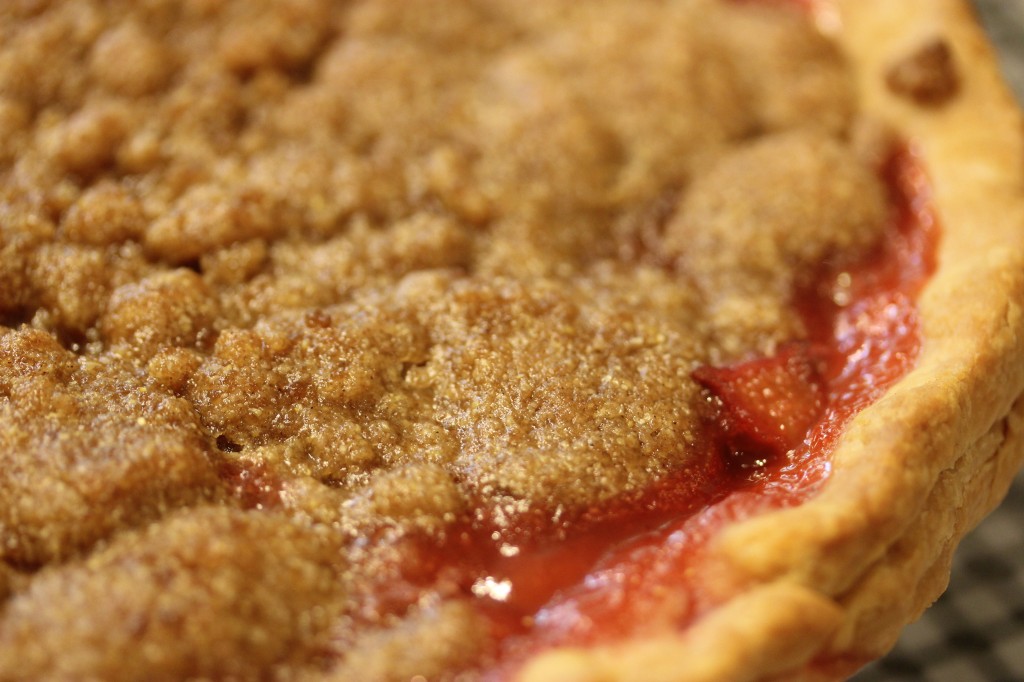Rhubarb is a funny word. “Getting into a rhubarb” is an old-fashioned yet common expression, one I have yet to find the origins of. Rhubarb has been cultivated for over 5,000 years, beginning in China where it began its life as a spice and medicine. Rhubarb, in the age of Marco Polo, was pricier than saffron or cinnamon. Cooking with rhubarb is something that began only in the 1600’s as sugar became available as a sweetener.
The fruit came to America only in the 1820s and quickly spread across the country. In a very warm climate, the plant will grow year round, but in temperate areas freezing ends the season. In the Northwest, where I grew up, they manage to get in two rhubarb seasons, which is why I remember it “always” being around. It’s only use, I thought as a child, was in strawberry-rhubarb jam. Sometimes I could truly enjoyed that flavor, and sometimes I think my mother skimped on the sugar. [Rhubarb, under sweetened, is bitter to the end.] Or perhaps, in Oregon, that second season of rhubarb was harvested in warmer days with more time for the fruit to become naturally sweet.
The search for just how to sweeten rhubarb has been intense, in part to save the expense of sugar. In some districts of England, the first harvest of the year comes by candlelight in special forcing sheds. The result is a sweeter more tender vegetable.
Ah, in most of the world, rhubarb is a vegetable. In the United States, thanks to a 1947 New York court ruling, rhubarb is a fruit. Why the dispute? In those days, there were higher tariffs on vegetables than on fruits. It would seem that the Rhubarb Lobby was active 65 years ago.
At our Kingston farmers market, Suzen saw stacks of fresh rhubarb. She grabbed one.
“Your job,” she began, “is to find a recipe.”
I smiled. “I know just the …”
“No jam,” she cut me off.
I was not upset. We have the wonderful book Pie by Ken Haedrich. A quick check of the index, and this beauty appeared. Suzen was delighted to find a cornmeal topping. And, as a crumble, it’s easy to top off this pie. There is no grinding of teeth or utterances of ancients Anglo-Saxon phrases that so often come when trying, say, to make a lattice top.
We both were delighted with the look and then the taste of this pie. Hey, it’s the Fourth of July. You can go out, buy fireworks, and before sundown have this pie cooling on your rack!
For pastry here, you can use you favorite pie pastry or, try our search function, and you’ll find Ken’s own flakey pastry recipe. Which is, of course, excellent.
Strawberry Rhubarb Pie
Servings: 6-8 good pieces from a 9” pie
Ingredients:
For the filling:
- 3 cups fresh rhubarb stalks sliced crosswise ½ inch thick
- ¾ cup granulated sugar
- 1 ½ tablespoons fresh lemon juice
- Grated zest of 1 lemon
- 4 cups hulled and halved (quartered if large) fresh strawberries
- ¼ cup quick-cooking tapioca
For the cornmeal crumb topping:
- ¾ cup all-purpose flour
- ¼ cup fine yellow cornmeal
- ⅔ cup firmly packed light
- ½ teaspoon ground cinnamon
- 1/4 teaspoon salt
- ½ cup (1 stick) cold unsalted butter cut into ¼-inch pieces
Preparation:
If you haven’t already, prepare the pastry and refrigerate until firm, about 1 hour.
On a sheet of lightly floured waxed paper, roll the pastry into a 13” circle with a floured rolling pin. Invert the pastry over a 9” deep deep-dish pie pan. Take off the wax paper. Tuck the pastry into the pan, without stretching it, and sculpt the edge with an upstanding ridge. Place in the freezer for 15 minutes. Preheat the oven to 400ºF.
Combine the rhubarb, granulated sugar, lemon juice, and lemon zest in a large bowl. Toss well to mix, then set aside for 10 minutes.
Add the strawberries and tapioca to the bowl and toss well. Scrap the filling into the chilled pie shell and smooth the top with your hands. Place the pie on the center rack and bake for 30 minutes.
While the pie is baking, begin the topping. Combine the flour, cornmeal, brown sugar, cinnamon and salt in the bowl of a food processor. Pulse several times to mix. Scatter the butter over this mixture and pulse until the mixture resembles fine crumbs. Empty the crumbs into a large bowl and rub between your fingers to make large, buttery crumbs.
Remove the pie from the oven and reduce the temperature to 375°F. Carefully spread the crumbs evenly over the surface of the pie. Gently tamp them down. Place the pie on an aluminum cookie sheet to catch any escaping liquid. Rotate the pie so that the half that was facing the back will now be facing the front of the oven. Return the pie to the oven and continue baking 30 to 40 minutes until the liquid at the edge of the pie is bubbling. If necessary cover the crumb top of the pie with aluminum foil for the last 10 minutes.
Remove from the oven and allow to cool for one hour before serving.
Source: Pie by Ken Haedrich with insights from Wikipedia

